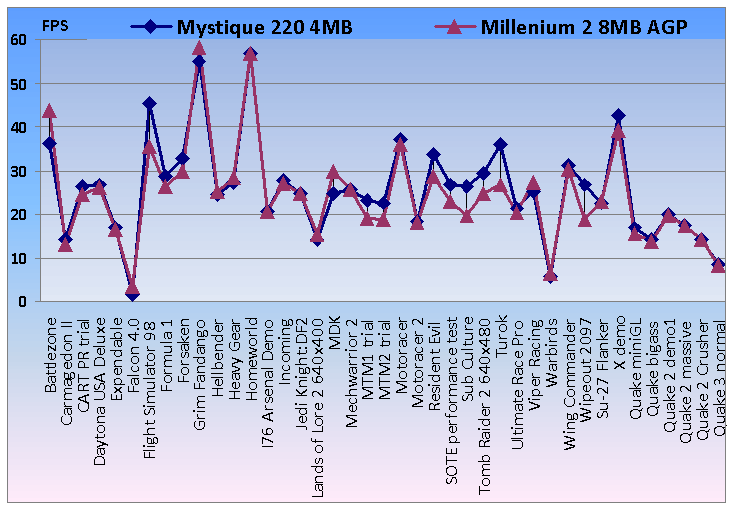Millennium 2
In summer 1997 Matrox released successor to the famous Millennium featured even higher 2d speeds, higher resolutions, crisper image output and for me most importantly a Direct3d compliant engine. Bad news was that the engine is only a little different from Mystique and is just as well feature poor. There are exception though- Millennium II supports 3d rendering in 32 bit colors and 32 bit Z-buffer. Well, those weren't the most missing feature of Mystique, but I understand it is good for CAD and similar no fun programs. Cards had 4 MB of memory and could be expanded with modules of 4, 8 or even 12 MB memory. Matrox used fastest possible WRAM interface greatly increasing memory bandwidth. Also AGP cards were produced in high numbers and that is what I am going to test with 8 megabytes of video memory. Dxdiag allows you to enable AGP texturing, but the built-in test fails and in fact even some games crashes at the start. So better to keep it off, it is likely just a driver hoax. While MGATweaker reports memory clock synchronous with the core, I am certain 2:3 ratio remains.

Matrox specifies Millennium II clock to 62,5 MHz, mine runs at 62,05 and some boards were even down to 60. Again, such undisclosed variations aren't very nice. Looks like Matrox had clock variation tolerance policy in place for very long time. Memory bus width remains 64 bit. Matrox was actually testing 128 bit bus back in the days of first Millenium and found out it added only 30% performance. Thanks to WRAM Milleniums could rival bandwidth professional market was used to.
Mystique reloaded
 With same shortfalls as Mystique it is awfully outdated 3d accelerator.
View Matrox screenshot gallery
With same shortfalls as Mystique it is awfully outdated 3d accelerator.
View Matrox screenshot gallery
When it comes to 3d Millennium II is like a Mystique with a bit slower clocks. Final stages of the pipeline are just as minimalistic. The only chance for proper transparency are color keys. None of vertex fog, texture mip mapping, and dithering is supported. Specular lighting is not being mixed with texture colors. The games look the same, I could just repeat what I wrote previously about Mystique experience. It is the last MSI compatible card. I expected little impact from more memory and AGP bus.

There are some good points for Millennium II. In absolute numbers the Mystique would be leading, but in relative numbers cards score the same because Millennium puts its 8 MB of memory to use in advanced games. For games that are truly playable faster clocked Mystique is still the better choice. The lower memory clock should be more than compensated by WRAM interface as long as serious resolution is used. Another unknown factor are drivers, Millennium II not being exactly a gamers card may lack some optimizations.
Gaming experience
There is a newer driver for the Millenium 2, but that does not mean improvement for 3d gaming. In fact, it brakes transparency in Forsaken. Checkbox for acceleration of fogging still does nothing. With larger framebuffer 32 bit colors are possible, but performance hit remains steep. Games like Populous, Take no Prisoners and Thief wisely reject the chip as hardware accelerator, and texture-less Shogo should do the same.
 The creepy feeling of hardware masochism.
The creepy feeling of hardware masochism.
Overclocking
The formula is different from Mystique but core/memory ratio cannot be set since memory clock is set by ramdac. Tweakers also don't support memory timings so all that is left is good old clocking. Top speed is almost 67 MHz, most probably because of limitation of the TVP3026 converter which cannot exceed 100 MHz memory signal. Less than 10% difference is not interesting enough for me to go through the benchmark suite again.
Conclusion
For a gamer Millennium 2 with price way higher then Mystique did not make sense. 3D on this board is only a plus to the excellent 2d engine with great quality output and the board was not presented as a gaming product so there is no criticism from me. But it is obvious competing semi-professional cards Permedia 2 and Revolution 3D offered much better 3d. Matrox had to hold on a bit longer to cover gamers with G200, but that advanced architecture is not vintage enough to be covered here. Last stop is much less known G100, which looks similar to Mystique and Millennium II, but actually hides quite a few changes.
Continue to Productiva G100 review